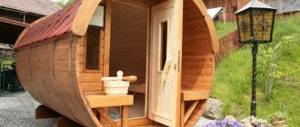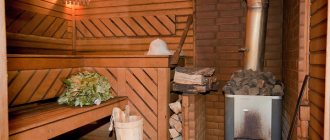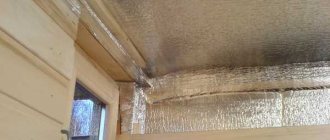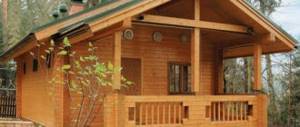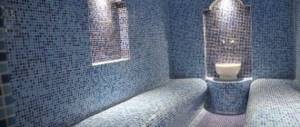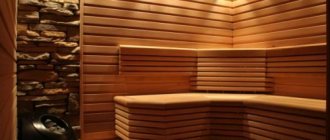Cover yourself in mud, bury yourself in sand or sit in a refrigerator - what would you do to cleanse your body and spirit? You will be surprised at the answers given to this question by residents of different countries. The concept of personal hygiene in the modern world does not vary too much in individual countries, but bathing traditions are often strikingly different. We are used to perceiving a steam room as relaxation at high temperatures with thick steam and a vigorous massage with a broom. But the baths of the peoples of the world can surprise and sometimes shock with their original traditions.
Even European versions of bath procedures have unique features. The differences relate not only to temperature conditions, but also to the appearance requirements for visiting the steam room. And numerous oriental techniques amaze with their exoticism. Every nation in the world has its own unique traditions, and therefore there are simply countless types of baths. We have collected the most interesting types of procedures from different parts of the world to show the entire spectrum of global bath culture. Our native Russian bathhouse, which occupies a special place, was not left out either. It is distinguished not only by a number of unique traditions, but also by a rich history.
The roots of the modern Russian bath
It is not known exactly when exactly it entered the life of the Eastern Slavs, but we know that life in Rus' has always been closely connected with the bathhouse. This probably happened back in the days of paganism, and since then the bathhouse has been perceived not only as a place for ablutions, but also as a cleansing of the human spirit. The importance of these procedures for our ancestors is evidenced by the fact that when an agreement was concluded with Byzantium in 907, it included a separate clause stating that the ambassadors of Kievan Rus could freely visit the baths of Constantinople. Also, mention of the Russian bathhouse is found in the legendary chronicle “The Tale of Bygone Years” (dating back to the beginning of the 12th century).
In the past, people in villages took a black bath. The bath building was a wooden frame without a chimney, and the fireplace was located directly in the steam room. The hearth was covered with a special grate on which stones lay. When the wood in the hearth burned, it heated the stones. Smoke came out through a small window and an open door. At the same time, the floor, ceiling and walls in the steam room were evenly heated. The walls were covered with soot. It was believed that she disinfected the tree.
In this way, the bathhouse was heated for two to three hours, after which the ash and coals were taken out of the steam room, and people could go and take a steam bath. It is noteworthy that in the past, births even took place in a steam room heated in this way. For comparison, a white sauna is now common, in which the stove is located in the dressing room, and not in the steam room. The building itself has a chimney, and therefore the smoke does not enter the steam room, but is immediately discharged outside.
Most often, bathhouses were built near ponds, into which steaming people jumped even in winter to cool off their bodies, which horrified visiting foreigners. They were no less surprised by the tradition of rubbing the body heated in the steam room with snow. Saturday was considered a bath day in Rus', when people spent half a day heating a steam room to relax in it after a week of work.
It is noteworthy that in home baths it was customary for everyone to take a steam bath together - women, men, and children. But in public baths, a ban was still introduced on staying together in the steam room, and there were separate male and female halves. And in the middle of the 18th century, there was even a ban on male children over seven years old being in the female quarters.
In the 19th century, they began to keep records of bathhouse establishments, and the following data has reached us that at the beginning of the century before last, in Moscow alone there were officially seventy state-owned bathhouses and about one and a half thousand private steam rooms. At the beginning of the twentieth century, even every medical institution had a bath complex at its disposal. By that time, doctors appreciated the beneficial effects of bath procedures on human health and began to prescribe them for the treatment of a number of diseases. For example, obesity, gout, rheumatism and many other ailments were treated in the steam room.
In 1808, the famous Sandunovsky baths were opened in Moscow, which still operate today, enjoying fame among modern steam lovers.
Swedish bath bastu
The main feature of the bathhouse in Sweden, which is called bastu, is its mobility and compactness.
The structure can be equipped in a few hours almost anywhere: on the lower floors of houses, verandas and attics. It is built from timber or industrial panels. The outside of the building is sheathed with mineral heat-insulating material and clapboard. The Swedish bath consists of just one steam room. It uses a powerful electric oven as a heater, which can warm up the room in half an hour. The basta must be equipped with a steam generator. Therefore, here you can adjust the appropriate humidity and temperature indicators. The most favorable microclimate is achieved at temperatures up to +65 degrees and humidity 60-65%.
Another feature of the Swedish bath is a kind of ventilation. The principle of its design is often used in Russian baths due to its high efficiency. The inlet and outlet openings are equipped at the bottom and equipped with valves. Air enters through the inlet under the furnace, passes through the heating element and rushes to the ceiling.
The air mass that “entered” must be forced out through the outflow by pressure force. Since the vent is located at a height of 30 cm from the floor and is equipped with a box leading to the top, near-floor “exhaust” air is released from the room. Good circulation makes it easy to breathe in such a steam room. This ventilation system resembles an inverted glass.
Bathing traditions of northern Europe
The most famous type of European bath in our area is the Finnish sauna. Its distinctive feature is very high temperatures (up to one hundred degrees) with low humidity. You won't see thick steam here. Extremely high temperatures in tandem with dry air cause the human body to quickly begin to remove fluid from the body, and sweat immediately evaporates directly from the surface of the skin. This way the skin is protected from overheating.
You should not enter the sauna with metal objects on your body, as under the influence of high temperatures they will quickly heat up and can burn you. Therefore, it is better to leave all rings, earrings and chains at home. But you need to take a long towel with you to the steam room to cover the wooden bench in the sauna. Without this accessory, you risk burning your body.
Another northern European power, Germany, has very interesting bathing traditions. In the modern culture of this country, large bath complexes are developed, divided into two parts. In one there are baths, and in the second you can have fun in pools with water slides. It is interesting that if you are allowed to wear swimming trunks and swimsuits in the pools, then in the bathhouse you must take off even these skimpy clothes. It is allowed to cover nudity with towels. The ban on swimsuits is due to the fact that local bathhouse attendants are confident that synthetic fabrics, when exposed to high humidity and high temperatures, begin to evaporate harmful substances. For the same reason, rubber slippers are prohibited in bathhouses in Germany.
Another feature of German baths is that they are considered a place for family time, and therefore there is no division into female and male halves. And the central event in the German bath is the so-called aufguss. This is a special and spectacular procedure, the likes of which are not found in other cultures. It consists in the fact that at a certain time in the steam room the bathhouse attendant begins to pour water on the stones on the stove. At the same time, aromatic essential oils are added to the water, and the room is filled with fragrant odors. After this, the bath attendant, using a special fan, begins to disperse the fragrant steam across the ceiling of the steam room and fan people with it, sprinkling jokes and jokes. The entire procedure takes up to 12 minutes, during which visitors are not allowed to walk in or out of the room so as not to let off steam.
In Iceland, baths make the most of the rich possibilities of nature. A key place is given to pools filled with volcanic thermal water.
These pools have special holes through which water flows into them. The walls in an Icelandic bath must be made of stone. They heat up and over time begin to release heat back into the room, which helps maintain a constant high temperature. But the steam in the hall is formed naturally - from the evaporation of thermal water from the pool.
Egyptian bath (rasul)
The main principle of rasul is mud wraps, which rejuvenate the skin and remove toxins from the body. Warming up of the body takes place in several stages, the temperature varies from 40 to 55, and the humidity remains high. This type of steaming is suitable for most people, but you need to choose the dirt carefully, as allergic reactions may occur.
Only a few types of baths are presented here; in fact, there are many more of them, and each has its own “zest”. Modern spa centers often offer several types of saunas to choose from; they can be alternated in order to achieve different effects. You should visit the bathhouse no more than twice a week, since high temperatures put a lot of stress on the heart, but regular visits can save you from many ailments.
French charm and English restraint in the bathhouse
Not much is known about the bathing traditions of aristocratic France, since it did not introduce any unique features into the global movement of steam lovers. But this picturesque region also has its own distinctive bathhouse traditions and rituals. The French prefer to steam in comfort and avoid extreme temperatures.
Having entered the bath complex and undressed, visitors first go to a special warm room. There they sit down on benches and wait for their bodies to warm up a little and prepare for the next procedure. Then they go into the steam room. True, for a Russian person, the French steam room can be called that with a big stretch, because the air temperature in it does not exceed forty degrees. At the same time, the air humidity in the bath is maintained at 60%.
But the main distinguishing feature of French baths is the next stage - visiting the bathroom. The person moves to another room where he takes a fragrant bath. He can independently choose which oils to add to his water, or listen to the opinion of a complex employee.
The Irish bathhouse is also of interest. Unlike the Finnish sauna, it does not knock the visitor off his feet with high temperatures. The Irish bath complex is divided into three rooms with different thermal conditions.
Distinctive features of baths in Ireland
| Premises | Temperature |
| In the first, you will enjoy a comfortable environment; | 25 degrees; |
| in the second - a little warmer; | 35 degrees; |
| in the third - even hotter; | 50 degrees. |
There in the steam room you will not find a heater on which water is poured to give off steam. But the person still sweats profusely, while it is easy for him to breathe, and he experiences comfortable relaxation. The room is heated with hot air, which comes from a special stove and goes through pipes under the floor and along the walls.
The bathing traditions of the inhabitants of Foggy Albion have their own characteristics. The British also prefer average temperatures with low humidity. The air temperature in their bathhouse rarely exceeds 80 degrees, and they try to keep the humidity level below 50%. It’s difficult to call an English steam room or steam room, since there is no trace of steam there.
In this room of the English steam room it is customary to remain silent, relaxing in silence under the influence of the heat.
The most interesting stage in an English bath precedes the actual trip to the steam room. Before testing their body for heat resistance, the British, like the French, prefer to preheat the body. For this purpose, the bathhouse worker covers the client with hot stones - from the heels to the top of the head. The procedure takes about 15 minutes and is reminiscent of one of the areas of exotic massage - stone therapy.
After the steam room, residents of England go to a hall with a pool of cool water. In some cases, thermal water baths may be located in this room, since England also has hot springs. Visitors can also use the shower if they do not want to continue bathing procedures. Before leaving, clients drink a cup of tea in the relaxation room.
Japanese sento bath
The Japanese sacredly honor their traditions, and therefore today, like several centuries ago, they arrange their bathhouse in accordance with all ancient rules. The building of a Japanese sento resembles a Shinto shrine. A blue curtain with the hieroglyph “boiling water” is hung at the entrance.
Construction of a Japanese bath
Features of this type of Japanese bath:
- After entering the bathhouse, there is a section for removing shoes. It is common for men and women.
- From it, two different entrances lead to two separate rooms (datsuiba) - men's and women's, which are not very different from each other. The entrances are closed with special curtains. Here you can undress and leave your things in the locker. In modern sentos, it is in this room that vending machines with drinks and ice cream are installed.
- Between the men's and women's locker rooms there is a kind of pedestal (bandai), the height of which reaches 1.8 meters. A servant (usually a woman) sits on it and oversees the male and female halves of the sento. A clock hangs on top.
- Behind the bath area there is usually a boiler room called kamaba. The water is heated in it.
Bath procedures in sento
Features of bathing in a sento:
- The vacationer leaves his clothes in the locker room and goes to a small compartment where he can take a basin and other accessories.
- Next, he follows to the bath area, where hot and cold water flows from two hoses. A man washes his body thoroughly.
- After washing, the vacationer can begin to steam in a special pool with water, the temperature of which reaches +55 degrees. The procedures last about 15 minutes.
- At the end of the hall there are baths with water of different temperatures.
- After the session, the Japanese traditionally drink herbal tea. Some commercial sento offer additional procedures after washing - wraps, masks. Massage is very popular. It has an excellent healing effect.
Baths with thermal springs
The tradition of public places for ablutions and leisure was founded by the ancient Romans, who could not imagine their life without visiting thermal baths. The main requirement for the construction of these establishments was that there should be thermal springs nearby. Thanks to the peculiarities of the Italian climate, there were no problems with this, and therefore every major city was literally strewn with thermal baths.
Not only wealthy patricians, but also poor plebeians could visit the baths - this issue was given great importance in Ancient Rome. Even baths for commoners could include the following areas:
- walking parks;
- extensive libraries;
- exercise facilities;
- conversation rooms.
And this does not include rooms with swimming pools and steam rooms. Thermae for wealthy citizens included all of the above premises, but they were striking in the richness of their decoration. They were all marble columns, chiseled sculptures and luxurious mosaics.
A special order of procedures was observed in the thermal baths. The person had to warm up gradually. First, he entered a warm room heated to 40 degrees. There was a swimming pool where you could relax. Then you should go to the steam room with an air temperature of up to 70 degrees. This hall also housed a thermal water pool. In the third room the temperature reached 85 degrees. After this, the visitor went to a cooler room, where he could cool down in the next pool. And the final chord was a visit to the massage room.
The heat in the baths had two sources. The first is the natural temperature of water from thermal springs. And the second was a special stove, located under the floor, heated with wood. The heat was enough to maintain a constant temperature in the rooms, as well as to warm the stone sun loungers and benches. Modern baths have retained the order of the arrangement of halls with different temperatures, but, of course, today's Italian baths no longer shine with their former splendor.
In Hungary, they adopted the tradition of Roman baths and began to build their public baths on thermal springs. The buildings themselves look incredibly luxurious and are a pleasure to visit. Unlike Germany, public baths in Hungary are divided into male and female halves. But the attitude towards swimsuits is the same - entry into the steam rooms is prohibited in them. It is customary here to cover nakedness with special aprons, reminiscent of a kitchen accessory. Men's models consist only of the lower part, while women's models are equipped with bibs.
The sulfur baths in Tbilisi are also interesting. These Georgian public steam rooms are built on thermal springs, the water of which contains large amounts of hydrogen sulfide. The baths are not as light as the Roman baths, since their architecture is slightly different. As a rule, bath complexes are located in semi-basements with windows near the ceiling. The interior is filled with marble and picturesque ceramic tiles.
The steam room in Georgia is traditional, and the main feature is the pools. A person can relax in sulfur baths with hot or cold water, as desired.
Roman bath terma
The Roman bathhouse is the term of today.
There are many contradictions about which people first invented the bathhouse. Many historians believe that the founders of the bath business were the Romans and their famous thermal bath.
The Roman bathhouse, the terma, was a huge bathhouse with several rooms, each of which had different temperatures and humidity. The Romans introduced the bathhouse as a place for public gatherings for bathing, where people communicated, relaxed and had a good time.
The heating of a Roman Terma bath is a bit unusual. The so-called stove was located in the basement and heated the floor and all rooms. In the hottest room the temperature reached 85°C, so it was impossible to walk on the floor barefoot, because... the floor was a partition between the firebox and the bathhouse itself. Additionally, the bathhouse was heated with hot smoke, which passed through special chimney openings in the walls.
The Roman bath terma consists of several rooms:
The first room is a locker room, which is called apodytherium . There was no high temperature here, just normal room temperature.
The second room is called the tepidarium . The temperature in the tepidarium was about 40°C, which is enough to smoothly warm up the body before higher temperatures. The tepedarium provided a pool with warm water for swimming.
As soon as the body warmed up enough, it was necessary to move to the next, third room - the callidarium . Here the temperature was approximately 70°C, which is enough to relax in the bathhouse. The Callidarium also had a swimming pool, but the water in it was an order of magnitude warmer.
Well, the last, hottest room is the laconium . The temperature in the laconium reached a maximum of 85°C; not all vacationers moved into this room. Those who did steam in the laconium had to stay in the room for no more than 10 minutes, due to the high load on the body.
Despite the fact that the Roman bathhouse Terme had swimming pools, bathing took place as follows: vacationers rubbed themselves with oils, after which they washed off the dirty oil with water.
It should be noted that the Roman bathhouse was decorated exclusively with marble, which evenly distributed heat throughout the room.
Roman bath terma - general view
Today, the traditions of the Roman bathhouse terma have not been preserved; the area of the room, decorative decoration, as well as the method of heating the bathhouse have been completely changed.
Bath culture in tourist centers
Many of our compatriots love to relax in Turkey and are familiar with the traditions of the local bathhouse, called hammam. Now large resort cities are literally dotted with bath complexes, and more and more Turkish baths are gradually opening in Russia itself. People go there not only for the oriental flavor and beautiful interior, but also for unique procedures. They include:
- steaming the body;
- foam massage;
- wraps;
- relaxation in a hookah bar.
The temperature and humidity in the hammam are more favorable for children and people who are not avid steam lovers. The temperature is about 50 degrees, and the humidity does not exceed 20%. Breathing in such an atmosphere is easy and comfortable.
The body in the hammam is heated not by thick steam, but by lying on a heated marble slab. There is a swimming pool in the center of the main hall of the hammam, but unlike Russian and European traditions, swimming in it is prohibited. This pool is equipped to maintain a comfortable indoor humidity level. But you can wash off the sweat that appears on your body in the shower.
The main highlight of a visit to the hammam is a special massage performed with a lot of foam whipped on you. When the visitor has thoroughly steamed, the hammam worker begins the massage using a special washcloth mitt. A person receives not only a good kneading of the muscles, but also high-quality scrubbing of the skin of the whole body, and then a wrap. Each hammam also has a special room where visitors can drink tea after bathing procedures and even smoke a hookah.
Egypt, another popular country among our tourists, has a unique bathhouse culture. The Egyptian bathhouse is called “rasul”, and its history goes back centuries, when the pharaohs still ruled in that territory. In ancient times, bath procedures were considered by local priests from the point of view of healing various diseases. Nowadays, visiting a bathhouse for Egyptians does not have any sacred meaning, but is only a pleasant method of relaxation and recuperation.
A visit to Rasul involves several successive stages. First of all, a person goes to the shower to cleanse his skin. Then he goes to the steam room and after this they apply mud masks and wraps. This stage is aimed at cleansing and disinfecting effect.
In the Egyptian bath, they do not use one healing mixture for the entire body: a special mask composition is prepared for each part of the body.
The air temperature in an Egyptian bath is low - no more than 45 degrees. But humidity is constantly maintained at 65–80%. This allows you to use masks without fear that they will dry out instantly. With a mask applied to the body, a person spends about twenty minutes in the steam room, after which he washes it off in the shower. Now comes the turn of rubbing healing aromatic oils with antiseptic and softening properties into the skin. This process is accompanied by a shallow massage, which further relaxes the visitor’s body.
Turkish bath (hamam)
Hamam is one of the most popular baths around the world for several reasons. Firstly, the Turkish sauna is suitable for almost everyone due to its low temperature (50-60) and high humidity (almost 100%). Secondly, due to the popularity of holidays in Turkey (almost every hotel has a hammam), the Turkish bath culture has spread throughout the world. In the hammam it is customary to do a relaxing massage and wraps on a heated marble slab. If you want to get a good sweat, a Turkish sauna is unlikely to suit you.
Far Eastern bath ritual
Great importance is attached to the tradition of body cleansing in the Land of the Rising Sun. In Japanese bath culture, there are several different options for how to steam your body. Dry baths are very popular in Japan, which act on the body according to the principle of a steam room.
The man is lowered into a barrel filled with cedar wood sawdust or sea pebbles. Collections of medicinal plants are often added to them. The contents of the barrel are heated to 50 degrees. The wise Japanese found out that under the influence of high temperature the body begins to actively secrete sweat, which effectively absorbs the contents of the barrel. In turn, sawdust produces beneficial substances that penetrate well into the body through open pores on the skin. It is advisable to endure a ten-minute session in such a healing barrel, but inexperienced people may not be able to withstand such a temperature.
There is also a bath-bath option, when the barrel is filled with hot water. Often this is water from thermal springs. In public Japanese baths, one large barrel is intended for several people, like in European spas - jacuzzi. Near the inner walls of such huge barrels there are small benches on which people sit without interfering with each other. But before entering the barrel of water, the visitor must wash thoroughly in the shower, since the water in it is not changed for each client.
Another interesting feature of Japanese baths: in some steam rooms, visitors take ice cubes with them and chew them in the steam room. It is believed that this increases sweating and makes it easier to cope with high temperatures.
The traditions of going to the bathhouse in China are no less interesting. Modern Chinese bath complexes, according to the list of services, are close to comfortable hotels. In addition to steam rooms and rooms with swimming pools, there are also rooms with beds where you can stay overnight, and even concert halls. A set of bath procedures begins with a bath. The room has several Jacuzzis with water of different temperatures. Often bright petals of fragrant flowers swirl on the surface, and aromatic oils are added to the water.
Pairs may differ in different complexes. Some have compact cabins that are located right next to the jacuzzi. The air temperature in them does not exceed 80 degrees. In others, a huge stone blazing with heat can be transported into the steam room on special rails. Visitors pour water over it, causing the room to fill with steam. And to cool down after the steam room, some complexes offer visitors snow rooms. Generators produce artificial snow in them, and you can cool off there on the benches, sitting at a temperature of minus 10.
The real value of Chinese baths lies in the massages that follow a visit to the steam room. At your request, the massage therapist can work on every cell of the body or concentrate on a specific part of the body. Foot massage using bamboo rods is in great demand among bathhouse visitors.
Czech beer sauna
This innovation appeared in the Czech Republic about 9 years ago in the Chodovar brewery.
They say that visiting a beer steam room saturates the body with beneficial vitamins (beer contains a lot of vitamin B), and removes waste and toxins. The skin after this procedure is smooth and soft. The effect is noticeable for several weeks. According to some reports, bathing in beer can even protect a person from the evil eye. The essence of a beer bath is to heat the drink and mineral water in equal parts to a temperature of +37 degrees and fill the bath, which is traditionally presented in the form of an oak barrel. The duration of the session should not exceed 30 minutes. After the procedures, you need to wrap yourself up and sleep. It is not recommended to wash in water immediately.
Contraindications to visiting the beer steam room: changes in blood pressure, vascular inflammation, pregnancy, age under 12 years. It is undesirable to abuse alcoholic drinks while taking a bath.
Lakonicum walnut sauna
The Greek baths, called laconicum, were similar to the Roman ones; they gained popularity simultaneously with therms.
The design features and finishing options are similar to each other; predominantly ceramic or marble tiles were used. A characteristic feature of the Greek bath is that the room is round in shape, which is due to better heat distribution, according to the Greeks. The air temperature reached +70 degrees, humidity - 20%.
The source of heat was an open fireplace located in the middle of the bath, the smoke from which came out through a special lid in the ceiling. The source of water was baths and swimming pools. After the procedures, the servants bailed out the water, since there was no sewer system.
The Greek laconicum baths were of a public nature. After undressing, the Greeks wiped the body with oil and scraped off dirt from it using special devices. Then the bathers drank cold water on themselves to strengthen the body. And we could proceed directly to swimming.
Baths at the country hotel Artiland
Location: Moscow region, Balashikha, Novskoe highway, building 10.
Artiland is the best country hotel according to the Russian Hospitality Award 2020. A spacious bath complex for small and large companies has been built here.
In the “Healer's Bath”, steaming is carried out using medicinal herbs and plants. In the courtyard there are cold-water plunge pools and cedar barrels for contrasting bathing. You can also relax in a vat of herbal infusion and drink aromatic herbal tea.
View this post on Instagram
Posted by Country Club ARTILAND (@arti_land)Sep 27, 2020 at 12:51 PDT
In the “Karelian Bathhouse”, designed in the form of a Karelian hut, after a steam bath you can splash around in cedar barrels, but most importantly - lie in bed on the hay!
The “Family Bath” will appeal to both adults, who will appreciate the steam room, plunge pool and “Russian shower,” and children, for whom a steam room with a low temperature and a games room are open.
Before and after steaming, you can go fishing, cook a barbecue, play bowling, billiards and paintball, go horseback riding and spend time in a petting zoo on a farm or in a creative one.
Large companies are offered to rent separate sauna-cottages. In addition to several traditional steam rooms, Sibirskaya has a hammam and a relaxation room with a fireplace and an indoor swing. “Merchant” and “Boyarskaya” are ideal for bachelor and hen parties: the men’s area is decorated with cars, and the women’s area is decorated with mirrors in antique frames. In the cottage baths, guests will be offered a four-hand steam bath, honey rubbing, contrast dousing with homemade kvass and a variety of massages and wraps.
Bathhouse made from... manure - extreme for gourmets
The manure bath dates back to the times of Ancient Rus', when people were treated for joint diseases and problems with the cardiovascular system in this way. The essence of the procedure is this: a person is placed in a tank with manure, where he remains for 2 hours. Experienced fans of extreme bathing note that this procedure allows you to get rid of rheumatism.
Whether to practice manure bath sessions or not is up to you, but bath gourmets, like no one else, recommend such treatment and at the same time a kind of “challenge” for everyone, and how long can you stand in a manure barrel?
Temazcal Indian bath
“House of Hot Stones” - this is how the name of the Indian bathhouse is translated. In the old days, visiting this steam room was part of the ritual of serving the gods.
Construction of the Temazcal Indian bathhouse
A temazcal is a low and round structure made of unfired brick, stone or clay.
Its diameter is usually up to two meters. Due to its small dimensions, the bathhouse quickly warms up, and thanks to its unique round shape, condensation flows down the walls rather than dripping from the ceiling. A small window is made at the top of the building. The door, as in a Russian bathhouse, is traditionally arranged with access to the south side. The stove is placed immediately outside the door. The decoration of the steam room and its internal contents depend on the taste of the owner.
Rules for visiting the Temazcal Indian Bath
The temperature in the steam room can reach two hundred degrees. The Temazcal Indian bath is prepared for procedures in the following order:
- Close the door and heat the stove until the walls become hot.
- We lay volcanic stones in the middle of the room.
- We spray the walls with cold water to create steam in the room.
- Pour aromatic oils or previously prepared herbal healing decoctions onto the stones. They can be made from rosemary, wormwood, and eucalyptus.
- Prepare the corn leaves. They are the ones who are used to steaming in Temazcal.
- We lay banana leaves or straw mats on the benches.
- We prepare cold water to lower body temperature if necessary.
- Before entering, apply aloe juice to the body and face.
After the procedures, it is recommended to wrap yourself in a woolen blanket or sheet and rest for 30-50 minutes. Then be sure to replenish your water balance with herbal chamomile tea, yarrow decoction, vegetable or chicken broth. It is not recommended to be in a draft after the session, as you may catch a cold.
